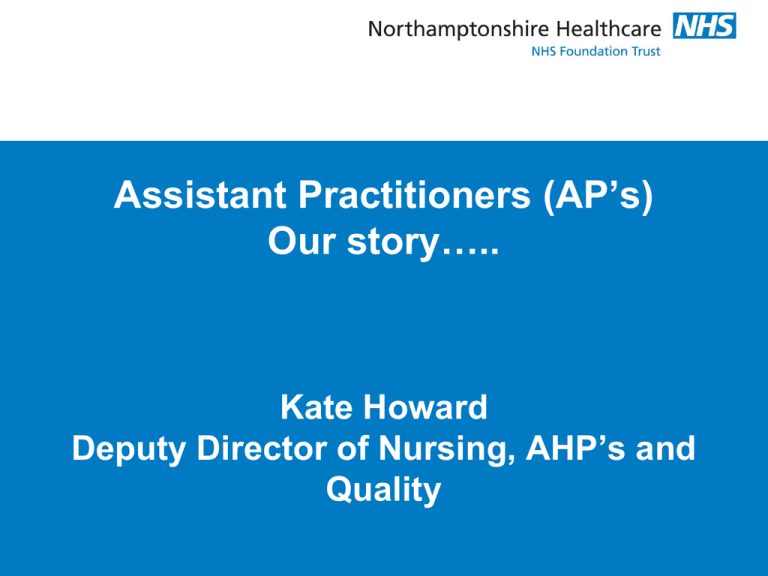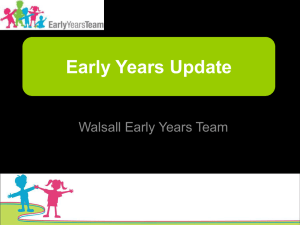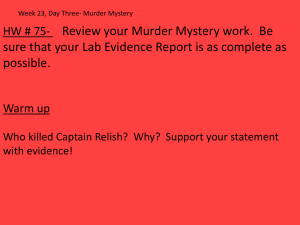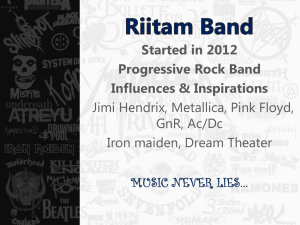Kate Howard, NHFT AP Presentation
advertisement

Assistant Practitioners (AP’s) Our story….. Kate Howard Deputy Director of Nursing, AHP’s and Quality Background What does NHFT do: • 4,500 staff • 1800 health professionals • 800 Bands 2 – 4 clinical staff • Multi functional sites across the county delivering the following services under 3 pathways: child, adult and specialist Background Specialist Adult and Children Mental Health in-patient and community Learning disability in-patient and community Forensic in-patient and community Crisis (MH) Early intervention in psychosis…. Prison health Rehabilitation ICT District Nursing Community Beds Palliative care in-patient and Community Frail and older persons hub Rehabilitation Child mental health inpatient and community Children’s community Service Looked After Children Background Current Assistant Practitioner Workforce: • 3 x community hca’s (qualified in 2013); one now accepted onto pre registration • 3 x hcas’s (1 x Mental Health, 1 x support worker: schools, 1 x community nurse) just about to qualify • 5 x hca’s (1 x mental health, 1 x community, 2 x Learning disability, 1 x specialist services) commenced in 2014 The AP journey - starting point Chaos… Challenges… This AP process was not without its challenges (or chaos) the key ones for NHFT : • Staff buy in • Concern that band 5’s will be at risk • Accountability • Safety • Role and responsibility • Training support – difference in ability • Band 4 job availability Role and Responsibility Issues -What does a band 4 do? -Competence in the community work force (band 3’s currently doing a hugh amount of independent, advanced work) -Who’s responsible for the practice? (linked to accountability) Outcome - A robust job description based on RCN guidance and examples from other Trusts - Clear identification of what a band 3, 4 and 5 does, what skills are needed (what is the difference) - Educating those supporting/ employing band 4’s around accountability, skill maintenance and accountability Staff Buy In Issue - Why do we need band 4’s - What will they do? - Are we going back to the old enrolled nurse programme? - We have no posts available - Will they replace band 5’s? Outcome - Education, discussion and regular bullet in’s - Looking at developing the workforce via transformation and consultation - Job descriptions which give distinct responsibilities to bands 4 and 5 Where we are now… How it works in practice… John was a 62 year old ex warehouse man whom over the past 30 years had a series of cardiac events. However 18 months ago at his appointment with a specialist ‘heart’ hospital they had told him in no uncertain terms that his heart could fail at any time. Because of the way this was communicated John was anxious, and suspicious of health professionals. However John went home and carried on! At home as John deteriorated it was obvious that he needed District Nurse support – he refused, until it got to a point where his wife was really struggling! How it works in practice…. The District Nurse went to assess him, he was hostile and refused to answer any questions.. John stated he didn’t want female nurses coming to see him! However John’s need was so great in terms of blood tests, vaccinations, equipment ordering, skin assessment, pain assessment etc that he required someone with the skills and experiences to visit as he could no longer get to the GP’s! How it works in practice… Luckily, we had a male trainee assistant practitioner associated with the District Nurse Team. Visit 1: TAP visit discussed rugby, football, and the TV from last night! Engagement meant that without knowing it the TAP was able to observe; how dry was the mouth? how breathless was John when talking/ resting? How tired was John? Skin integrity on hands and visible skin…What was the social/ environmental situation? How it works in practice…. Visit 2: Discuss England football results, favourite films.. Able to steer conversation into an assessment of need – TAP able to find out about equipment needs, ADL’s and Undertake SSKIN. Bloods taken… Visit 3: Join John in the garden for a glass of juice, comment on the cricket John is listening to on the radio, talk about the garden (picking up some tips as John is a keen gardener!) Raise the issue of equipment delivery dates – reduce John’s distress, try to reassure him that the equipment is there to help him and not because he is deteriorating and is losing his independence (a key anxiety).. John feels able to raise an issue around incontinence.. TAP able to undertake an incontinence assessment and referral… How it works in practice…. I hope you see the picture – the male to male engagement is paramount, but the skills the TAP was learning/ had learnt maximised the visits whilst maintaining John’s comfort around only having a male practitioner.. I think this is a real success story and I know it was a positive patient experience for John and his wife. Name and key details have been changed to protect confidentiality Where I would like to be… What next… Integration of more band 4 posts within the services. Promotion of this pathway to our AHP colleagues. Continued support of our current Trainee AP’s – providing them with an optimal education experience. On going development of the bands 1 – 8 education pathway. Evaluating how this fits with the DH Trailblazer programmes. Many thanks for listening.. Any Questions?











